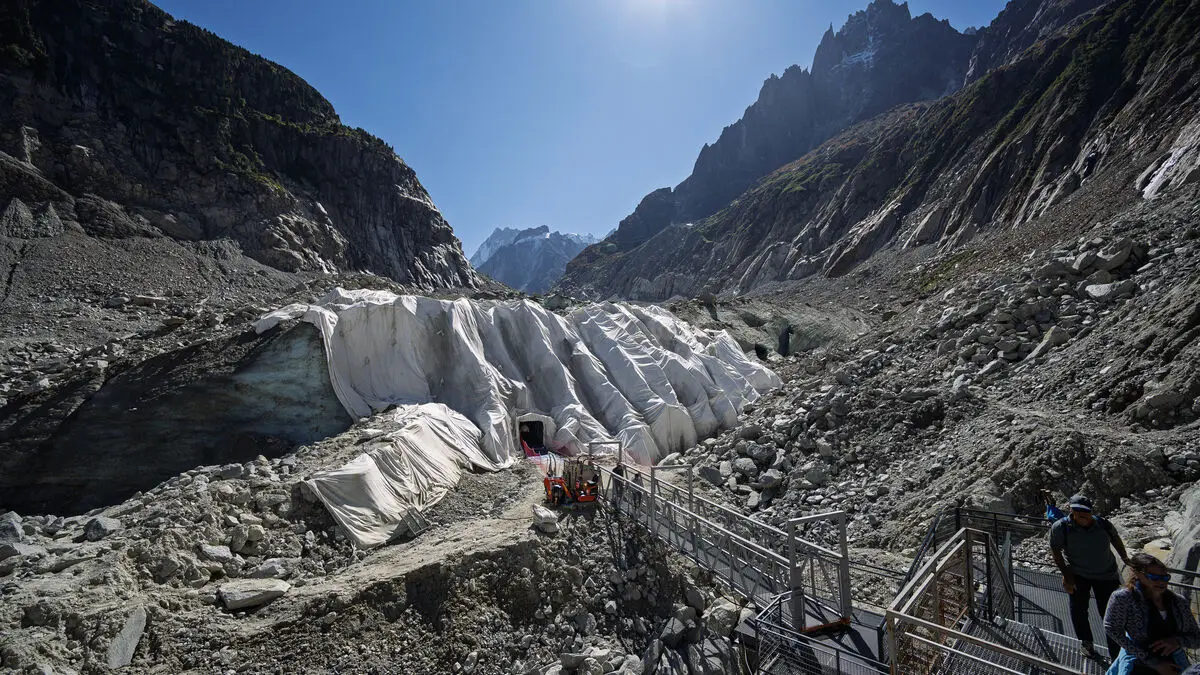It stretches straight into the glacier, the ice cave of Mer de Glace. The inside's shimmering blue walls are a sharp contrast to the outside, where the remains of the glacier are covered in gravel and stone – and white plastic, to prevent the cave from collapsing in the sun.
David Pedrace from Madrid looks at the walls with conflicting feelings.
You want to see it because it's beautiful, but at the same time it feels uncomfortable because by being here you're contributing to its disappearance.
France's largest glacier above Chamonix is a shadow of its former self. A new gondola, inaugurated in February last year, was put in place because it was becoming too far for tourists to get to the glacier.
Dramatic decrease
The change is dramatic. Since 1990, the glacier has retreated an average of 40 meters a year and thinned out by almost seven meters a year. By the 1990s, the glacier reached all the way to the small train station of Montenvers, from where you have to take the lift down.
"Every year we had to add 80 steps. That's the level at which the glacier is retreating. There is no other place in Europe that shows so clearly the dramatic impact of climate change," says Mathieu Dechavanne, CEO of Compagnie Du Mont-Blanc, which operates the lifts in the area.
In the Alps, global warming is happening faster than on the planet as a whole. Since the 1980s, temperatures have increased by 0.5 degrees per decade. This has hit the glaciers hard, which have lost almost 40 percent of their surface area since the turn of the millennium. Some have disappeared – and more are expected to follow.
Everything below 3,000 meters is very threatened, says glaciologist Christian Sommer at the German Friedrich-Alexander-Universität.
Soon gone
In a few years, Mer de Glace is expected to have retreated too far even from the new lift, and that will mean the end of the ice cave, Dechavanne believes. The lift – which can be used for other purposes – will not be extended.
"I think we will be able to send people under the glacier for another two to three years, three at most I would say. After that there is no ice left. But the idea was not to get as close as possible, because that is a losing battle," he says.
German Deborah Mildner takes her 1.5-year-old son Ben into the ice cave. He will probably never be able to show his children the inside of Mer de Glace.
"I hope people might think a little about what we are doing to the Earth. But at the same time, I don't think we humans are capable of changing ourselves," says Deborah Mildner.
There are about 4,000 glaciers in the Alps. Glaciers shrink when melting in summer is greater than growth in winter.
Between 2003 and 2015, the glacier area in the Alps decreased by 300 square kilometers, equivalent to 42,000 football fields. From 2000 to 2023, two gigatons of volume disappeared per year, a total equivalent to just over half of Lake Vättern.
Meltwater from glaciers is of great importance to the Rhine and Rhône rivers. If the glaciers disappear, it could lead to low water flows that affect agriculture and shipping.
Glaciers and permafrost serve a function in stabilizing land masses. As temperatures rise, the risk of landslides, avalanches, and rockfalls increases.
Glaciers are also important for tourism in many places, where skiing and hiking on glaciers are popular.





